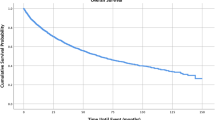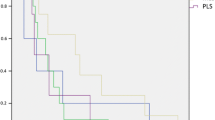Abstract
Background
Pleomorphic liposarcomas (PLS) is an aggressive, high-grade subtype of soft tissue sarcoma representing < 15% of liposarcomas. It most commonly arises in the retroperitoneum and proximal upper extremities. Current prognostic factors are centered around staging, which accounts for the grade, size, and location of the tumor in relation to the superficial fascia.
Methods
750 patients diagnosed with pleomorphic liposarcoma from the National Cancer Database were analyzed. Kaplan–Meier survival tables, log-rank tests, and Cox proportional hazards analysis were utilized to compare survival between groups within variables.
Results
The most common primary anatomical site was the lower limb/hip. The head/neck primary anatomical site demonstrated the highest 10-year overall survival probability, while the retroperitoneum/abdomen had the lowest (50% and 18.4%). Compared to the thorax/lung site, the following sites demonstrated a decreased risk of death: lower limb/hip (HR = 0.54; 95% CI: 0.35–0.82, p = 0.004), pelvis (HR = 0.49; 95% CI: 0.28–0.84, p = 0.010), and the retroperitoneum/abdomen (HR = 0.54; 95% CI: 0.33–0.89, p = 0.015). Both adjuvant radiation (HR = 0.64; 95% CI: 0.48–0.85, p = 0.002) and neoadjuvant radiation (HR = 0.70; 95% CI: 0.49–1.00, p = 0.049) provided a survival benefit to patients. There was an increased risk of death for every 10-year increment in age (HR = 1.31; 95% CI: 1.12–1.45, p < 0.001).
Conclusion
Statistically significant prognostic factors for PLS include primary anatomical site, age, Charlson-Deyo Comorbidity Index Scores and the use of neoadjuvant and adjuvant radiation.




Similar content being viewed by others
References
Chang H, Du X, Rao X, Zhou Q, Shi F, Yang S (2018) Pathological diagnosis of retroperitoneal tumors. In: Luo CH (ed) Retroperitoneal tumors. Springer, Dordrecht
Dalal K, Kattan M, Antonescu C, Brennan M, Singer S (2006) Subtype specific prognostic nomogram for patients with primary liposarcoma of the retroperitoneum, extremity, or trunk. Ann Surg 244(3):381–391
Dodd L, Jiang X, Rao K, Bui M (2015) Pleomorphic liposarcoma: a cytologic study of five cases. Diagn Cytopathol 43(2):138–143
Downes K, Goldblum J, Montgomery E, Fisher C (2001) Pleomorphic liposarcoma: a clinicopathologic analysis of 19 cases. Mod Pathol 14(3):179–184
Ecker B, Peters M, McMillan M et al (2016) Preoperative radiotherapy in the management of retroperitoneal liposarcoma. Br J Surg 103(13):1839–1846
Gebhard S, Coindre J, Michels J et al (2002) Pleomorphic liposarcoma: clinicopathologic, immunohistochemical, and follow-up analysis of 63 cases: a study from the French Federation of Cancer Centers Sarcoma Group. Am J Surg Pathol 26(5):601–616
Gerrand CH, Bell RS, Wunder JS et al (2003) The influence of anatomic location on outcome in patients with soft tissue sarcoma of the extremity. Cancer 97(2):485–492
Ghadimi M, Liu P, Peng T et al (2011) Pleomorphic liposarcoma: clinical observations and molecular variables. Cancer 117(23):5359–5369
Goldblum J, Enzinger F, Folpe A, Weiss S (2014) Enzinger and Weiss's soft tissue tumors, 6th edn. United States, Philadelphia
Gustafson P, Arner M (1999) Soft tissue sarcoma of the upper extremity: descriptive data and outcome in a population-based series of 108 adult patients. J Hand Surg Am 24:668–674
Hornick J, Bosenberg M, Mentzel T, McMenamin M, Oliveira A, Fletcher C (2004) Pleomorphic liposarcoma: clinicopathologic analysis of 57 cases. Am J Surg Pathol 28(10):1257–1267
Hui D (2015) Prognostication of survival in patients with advanced cancer: predicting the unpredictable? Cancer Control 22(4):489–497
Kattan M, Leung D, Brennan M (2002) Postoperative nomogram for 12-year sarcoma-specific death. J Clin Oncol 20(3):791–796
Lin PP, Guzel VB, Pisters PWT et al (2002) Surgical management of soft tissue sarcomas of the hand and foot. Cancer 95:852–861
Pilotti S, Della Torre G, Lavarino C et al (1998) Molecular abnormalities in liposarcoma: role of MDM2 and CDK4-containing amplicons at 12q13-22. J Pathol 185:188–190
Rieker RJ, Stefan J, Christine B et al (2002) Distinct chromosomal imbalances in pleomorphic and in high-grade dedifferentiated liposarcomas. Int J Cancer 99(1):68–73
Rubin BP, Fletcher CD (1997) The cytogenetics of lipomatous tumours. Histopathology 30:507–511
Wang L, Ren W, Zhou X, Sheng W, Wang J (2013) Pleomorphic Liposarcoma: a clinicopathological, immunohistochemical and molecular cytogenetic study of 32 additional cases. Pathol Int 63(11):523–531
Wang L, Luo R, Xiong Z, Xu J, Fang D (2018) Pleomorphic liposarcoma: an analysis of 6 case reports and literature review. Medicine 97(8):e9986
Funding
This manuscript had no funding sources.
Author information
Authors and Affiliations
Corresponding author
Ethics declarations
Conflict of interest
The authors declare no conflict of interest.
Ethical approval
The need for ethical approval was waived by the Creighton University Biomedical IRB (project number: 1427838) and formal consent was not required.
Additional information
Publisher's Note
Springer Nature remains neutral with regard to jurisdictional claims in published maps and institutional affiliations.
Rights and permissions
About this article
Cite this article
Lee, H.G., Aurit, S., Silberstein, P. et al. Primary anatomical site as a prognostic factor for pleomorphic liposarcoma. J Cancer Res Clin Oncol 146, 1501–1508 (2020). https://doi.org/10.1007/s00432-020-03204-y
Received:
Accepted:
Published:
Issue Date:
DOI: https://doi.org/10.1007/s00432-020-03204-y




